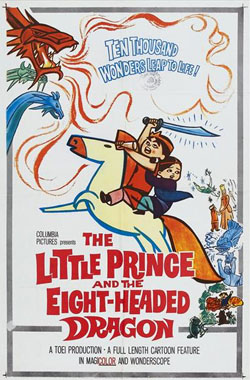And speaking of anime that did influenced Samurai Jack, here are a series of trailers for an early anime feature film from the 1960s called The Little Prince and the Eight-Headed Dragon (or Wanpaku �ji no Orochi Taiji, in its indigenous Japanese), which is one of the major influences for my all-time favorite action cartoon, Genndy Tartakovsky�s Samurai Jack! Here! Follow this YouTube link:
The Little Prince and the Eight Headed Dragon / Trailers - YouTube (
http://www.youtube.com/watch?feature=player_embedded&v=ulQ5jumhk1Y)
Here is Cartoon Research�s word on what is also one of the major influences on Genndy Tartakovsky�s Samurai Jack:

"Tōei Dōga�s Wanpaku �ji no Orochi Taiji/The Little Prince and the Eight-Headed Dragon; released on March 24, 1963 in Japan, and by Columbia Pictures on January 1, 1964 in America�was marketed in America as a Japanese fairy tale. It was more than that; it was a portmanteau, bowdlerized for children, of probably the three most well-known Shintō myths, written down in the Kojiki and the Nihon Shoki about 700 A.D. but orally much older. In the myths, Susanō is the youngest son of the principal Japanese gods, Izanagi and Izanami, the creators of the earth and of humanity. Susanō is the adult storm god and the Shintō equivalent of Loki, strong and brave but very hot-tempered and headstrong; a troublemaker and god of chaos.

"In The Little Prince and the Eight-Headed Dragon, he is Prince Susanō, the youngest son of King Izanagi and Queen Izanami, about eight to ten years old. He plays with animal companions, principally Akahana (�Red Nose�), the talking black rabbit. One day, his mother disappears. When he asks where she is, his father tells him that she �has gone to another place�. The audience understands that this is a euphemism meaning that she has died, but Susanō takes it literally and throws a temper tantrum, swearing to find her and bring her home. Susanō builds a boat and sails with Akahana to the Crystal Palace, the court of his older brother, Tsukuyomi, in the Land of Night (the moon and the Shintō moon god). When he does not find her there, he throws another tantrum and destroys part of the moon court. Despite this, Tsukuyomi gives him a magic ice crystal and sends him on to their younger brother, the fire god. Susanō fights him, too, defeating him with the magic ice crystal and Akahana�s help. While in the Land of Fire, Susanō gets another companion, the Titan Bō, a friendly fire giant. Next, the three continue on to the Land of Light, the kingdom of Susanō�s older sister Amaterasu (the Shintō sun goddess). Susanō again �accidentally� destroys part of her court. Amaterasu, frightened, hides in a cave, plunging the world into darkness. The inhabitants of the Land of Light throw a big party outside the cave to lure her out. (In Shintō mythology, they throw a pornographic orgy.) Finally, the three go to Japan�s Izumo Province, where Susanō meets Princess Kushinada, a little girl his own age. She tells him how Izumo is being terrorized by Yamata no Orochi, the eight-headed dragon who has already eaten her seven sisters. Susanō pledges to kill the dragon, with the help of Akahana and Bō, and a flying horse sent by Amaterasu. At the end, Susanō�s mother�s spirit returns briefly to tell him that she cannot return with him, but he no longer cares so much because he has fallen in love with Kushinada and resolved to stay in her country.

"The Little Prince and the Eight-Headed Dragonwas the most advanced Japanese animated feature up to this time. Tōei Dōga had finished practicing the basics of theatrical cartoon animation and was ready to experiment under director Yūgo Serikawa with something new. The plot was juvenilized, but the art direction by animation director Yasuji Mori abandoned the naturalistic, soft Disney look and emphasized modernist, stylized, almost abstract art in both the background and character design. The color, also abandoning traditional Disney, is in blocks of bright, primary hues. The characters exhibit no black outlines or shading. The feature was the first filmed in Tōei Dōga�s TōeiScope anamorphic widescreen format, similar to CinemaScope in America. Tōei Dōga spent money on it, commissioning composer Akira Ifukube, best-known for his Godzilla score, to write the music. (No monster-movie fan will fail to recognize�s Ifukube�s distinct music, which is clear on the Japanese trailer.)The Little Prince and the Eight-Headed Dragonmarked the emphasizing of several filmmakers who would become famous in the anime industry; notably assistant directors Isao Takahata and Kimio Yabuki, and key animators Yasuo Ōtsuka and Yōichi Kotabe.
The Little Prince and the Eight-Headed Dragon received accolades in Japan and internationally. It got the 1963 Mainichi Film Awards� Noburō Ōfuji Award for excellence in animation; the only theatrical feature to win it until Hayao Miyazaki�s Lupin III: The Castle of Cagliostro(1979). It was officially recommended by both the Ministry of Education and the Ministry of Health�s Central Child Welfare Council. The Venice Film Festival gave it the Bronze Oscella (presumably for screenwriting).
In America, it was released by Columbia Pictures as a children�s matinee feature. Wikipedia (edited): �Its Japanese origin was downplayed, as was standard practice at the time, with William Ross, the director of the English dubbing, credited as director, and Tōei�s Fujicolor and TōeiScope widescreen processes rebranded as �MagiColor� and �WonderScope� respectively.� It received little critical notice at the time, though recently American director Genndy Tartakovsky has acknowledged it as a major influence on his 2001-2004 Emmy- and Annie-award-winning TV series Samurai Jack.�
Seriously, did you know that Genndy Tartakovsky cited this early anime movie as a major influence on Samurai Jack, which is my all-time favorite action cartoon? Also, what�s your word on The Little Prince and the Eight-Headed Dragon and especially its influence on my all time favorite action cartoon Samurai Jack?




